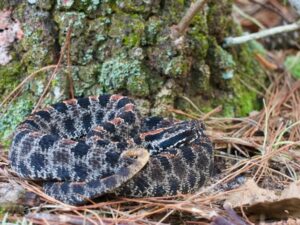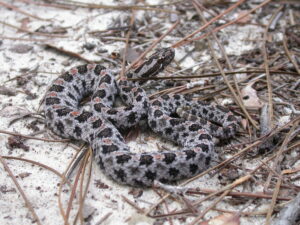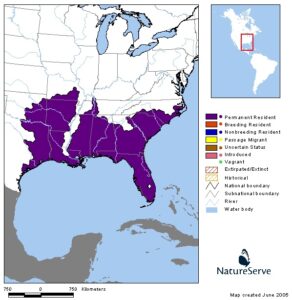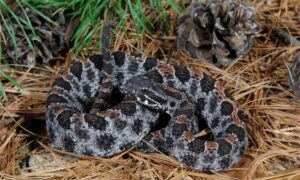The pygmy rattlesnake or pigmy rattlesnake is a small, diurnal pit viper species native to the Southeastern United States. It is a solitary snake that socializes only for breeding and can rarely be seen due to its excellent camouflaging capabilities. They are also good swimmers, but the buzzing sound made by its tiny rattle can only be heard from a few feet away.
Scientific Classifications
- Suborder:Serpentes
- Family:Viperidae
- Genus:Sistrurus
- Species:S. miliarius
Conservation Status
Subspecies
This snake has three recognized subspecies.
- Dusky pygmy rattlesnake (Sistrurus miliarius barbouri)
- Carolina pygmy rattlesnake (Sistrurus miliarius miliarius)
- Western pygmy rattlesnake (Sistrurus miliarius streckeri)
Description
Size
A full-grown adult reaches a total length of 40-60 cm (16-24 in), including the tail. The maximum recorded total length is 78.8 cm (31 in).
Color and Appearance
The background color is generally dull gray or tan, sometimes with an orange stripe running down its back. Usually, there are 23 rows of dorsal scales at the midbody. A series of subcircular or oval spots with somewhat regular edges forms the dorsal pattern of the snake. The spots on the flanks are usually round and almost of equal length and width. Pigmentation on the dusky-cream belly is mainly limited to faint blotches on pairs of adjacent scales.
The juveniles have similar coloration and patterns as the adults though they may be more brightly marked or paler, with the tips of the tails being yellow.
Are They Dangerous to Humans
Some of these snakes are very aggressive and strike furiously while others seem to be extremely lazy and don’t even try to rattle. But being unable to produce much venom, the pit viper is unlikely to deliver a fatal bite to an adult human. Nevertheless, a bite victim needs immediate medical attention.
The venom of the pygmy rattlesnake is cytotoxic and can poison tissues and cause hemorrhage. But it has no neurotoxins. The venom was used to develop the drug, eptifibatide, that prevents blood clotting in case of a heart attack. It is a somewhat unique type of venom that contains significant amounts of serotonin and associated tryptamine compounds.
Pygmy Rattlesnakes at a Glance
Distribution
It ranges from eastern and southern North Carolina southward through peninsular Florida and westward to Oklahoma and East Texas.
Habitat
The pigmy rattlesnake lives in sandhills, flatwoods, floodplains, mixed forests and also near marshes and lakes.
It is mostly seen in the summer, crossing the road late in the day or basking in the sun. They don’t dig their own burrows but use those dug by gopher tortoises and small rodents.
Lifespan
The pit viper lives for around 16 years.
Predators
It is preyed upon by skunks, Virginia opossums, raccoons, owls, fire ants, and other larger snakes.
Diet
The pygmy rattlesnake eats birds, small mammals, insects, lizards, frogs, and other snakes. It also consumes giant desert centipedes that it catches by active pursuit, grabbing, and flipping with simultaneous injection of venom to prevent injury by the prey. It ambushes lizards like skinks using its tail as the lure. The serpent adopts a sit-and-wait feeding strategy remaining coiled for days on end.
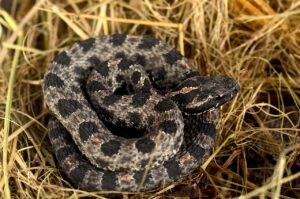
Reproduction
Ovoviviparous (gives birth to live young from eggs that hatch inside the body)
Breeding occurs in spring, followed by a gestation period of 3-5 months. 3-9 babies are born in a litter in late summer or early fall. They stay near their mother for 7-10 days for protection and reach sexual maturity at 2 years of age.
Similar Species
Timber Rattlesnake
The timber rattlesnake, Crotalus horridus, is bigger in size with completely black tails.
Hognose Snakes
Hognose snakes have thick tails that don’t end in a rattle. Plus, they have a pointed and sharply upturned snout, unlike the pygmy rattlesnake.
Source
wildherps.com, a-z-animals.com, outdooralabama.com, pixabay.com, a-z-animals.com

